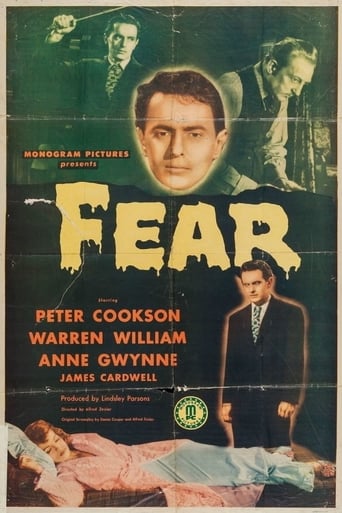JohnHowardReid
If it were not for the ending, I'd rate this moody, well photographed noir much higher than "2". But the way the movie concludes is a real cop-out that not only disappoints but that doesn't make a gram of sense. A pity!This Monogram version of "Crime and Punishment" is well-acted too, particularly by Peter Cookson (hero), Anne Gwynne (an unusual heroine), Warren William (in a rather small part - alas! - as the determined investigator), Almira Sessions (the shrewish landlady), and Francis Pierlot (as the grasping moneylender).It's a shame that all this clever writing, good acting, moody photography (Jackson Rose) and suspenseful direction (Alfred Ziesler) comes to nothing when the cop-out conclusion suddenly bursts on the screen. And the movie is now available on a very good Grapevine DVD too!
RanchoTuVu
Peter Cookson is a medical student who receives the bad news that the medical college he is attending is no longer able to afford to grant scholarships. His future becomes suddenly darker as he's faced with having to drop out with only one year to go. How this bad news affects his psyche is more or less what the film is about in a post-war 1940's era take on psychology and dreams. It seems to revolve around a sense of alienation portrayed through a surprisingly riveting dream sequence that occurs on a dark night on the railroad tracks. In spite of its meager budget this movie succeeds in rating fairly high up on the standards of my film scale.
sol1218
***SPOILERS*** Updated version of the Fyodor Dostoevsky crime classic novel "Crime and Punishment" as well as Fritz Lang's 1931 classic crime film "M" but with a major twist in the end. The person committing the crime does get what's coming to him but not the way he and we watching the film expected it to be. Medical student Larry Crain, Peter Cookson, is down to his last dollar and about to be evicted from his boarding house and thrown out of medical school for not being able to pay the tuition. Desperete for cash to pay his bills and stay afloat Larry goes to collage Prof. Stanley, Francis Preriot, who besides teaching medicine is also the school's unofficial loan shark as well.Things don't go that well with Larry and Prof. Stanley who demands a cut of 20% for every dollar he lends him even before Larry has a chance to pay it back. Talking things over with his fellow students about Prof. Stanley Larry hears that the professor doesn't believe in banks and has all his cash in his apartment. This gives Larry the bright idea of whacking Prof. Stanley and taking his money the next time he sees him to pay him back what he loaned him. Tricking Prof. Stanley to turn his back on him by trying to pawn off a silver ashtray Larry smashes his skull in with a fireplace poker killing him. But as Larry soon finds out the place where Prof. Stanley keeps his cash a steel safe-box isn't that easy to open. And when Larry finally opens it a number of Prof. Sanley's customers, fellow medical students, are banging at his door trying to get a loan from him.It's all downhill for Larry from then on with after whacking Prof. Stanley in his hast not taking a cent of the what seems like thousands of dollars that was in his safe-box but also freaking out the next day when an article he wrote for a local crime magazine was accepted and him being given a $1,000.00 check for it! There's also the fact that the police are now on the case of Prof. Stanley's murder with Larry feeling that their on to him as well and he'll soon to be arrested for it.****SPOILERS*** Guilt ridden and at the point of hysterics Larry's consciences starts to take over. With Det. Shaffer, Naston Paiva, seeming to stalk him at every turn and police Captain Burke, Warren William, taking a keen interest in him in the Prof. Stanley murder investigation. Larry now feels for certain that his goose or butt is going to soon be cooked in the state's electric chair. The surprise ending in the movie takes a while to digest in that it come on so unexpectedly that all the characters in it have to be reintroduced to us. That's after Larry gets away Scott-free as an innocent but mentally unstable man the house painter,Earnie Adams, confessed to the murder that he in fact committed!
Honus
Maltin's summary, and his star-and-a-half rating, for this quickie film noir fails to put it in the context of other, far more dismal Monogram productions. "Fear" has lots of interesting camera-pushes, nice use of close-ups, relatively interesting lighting, and a great nightmare montage. Plus, an expressive touch at the moment the key murder takes place (which I won't reveal) is just brilliant. Three things link this film to Fritz Lang's work--the marked coat (from "M") the dream-frame ("The Woman in the Window"), and perhaps most explicitly the palmreading of Larry's hand, revealing an "M", which stands for. . . . [supply your own dramatic music here]. Noir fans should seek this one one out for sure. Others may not be so impressed.



